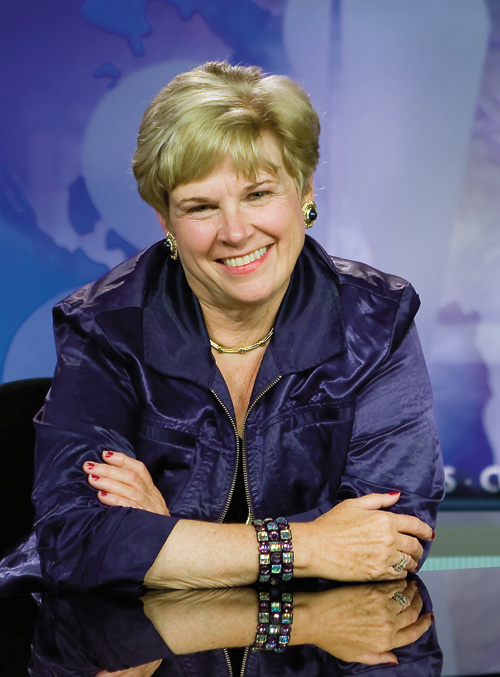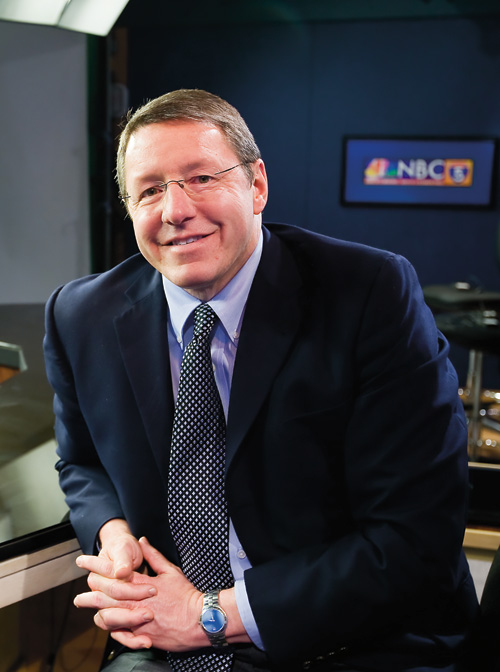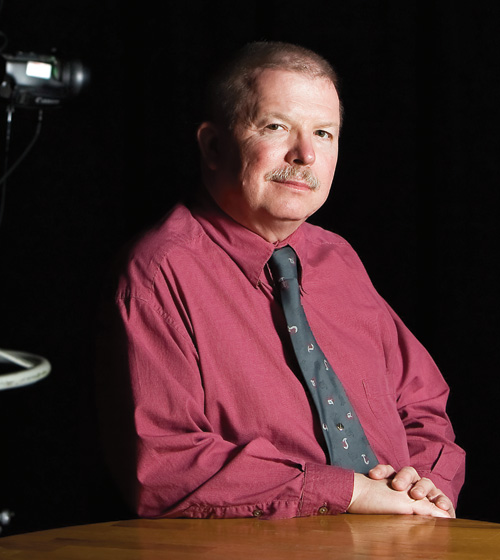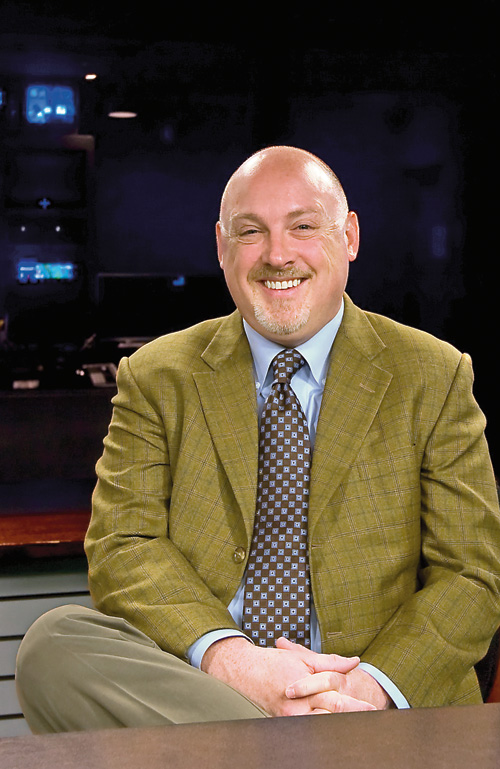 Medford is an unlikely hub of broadcast activity. As the stations struggle to survive, consolidation, combined newsrooms and other partnerships are possible. That would irreparably change a very special small American TV market.
Medford is an unlikely hub of broadcast activity. As the stations struggle to survive, consolidation, combined newsrooms and other partnerships are possible. That would irreparably change a very special small American TV market.
 |
Above: Although she once vowed that she would never follow her father into broadcasting, Patsy Smullin eventually became her father’s successor as owner-operator of KOBI. To this day she takes phone calls at home from viewers.Below: Technology is key in staying ahead for KOBI, the flagship station of the sprawling and diversified California Oregon Broadcasting Inc. // Photos by Jamie Lusch |
 |
By Dan Cook
Patsy Smullin, the owner of Medford-based California Oregon Broadcasting Inc. (COBI), was awakened from slumber by the jangling of her home phone one night in April. Groggily reaching for the offending device, she noticed it was 4 a.m. Still, she answered.
“There’s a fellow on the line who wants to know what the laws are for burning wood,” she recalled. “I said, ‘Do you know what time it is?’ He said, ‘Yes, I just got off work. And your station [KOBI] says we can call any time with a question.’ He had me there. I told him I’d look up the answer and get back to him when I got to the station.”
Smullin’s customer service commitment is somewhat extreme; she has after-hours calls forwarded to her home phone. But it is nonetheless emblematic of the close connections that exist between Medford’s three main network affiliates and the viewers they serve.
Medford is an unlikely hub of broadcast activity. Isolated among mountains just north of the California border, it is far from any of the markets normally associated with media activity. Its rich broadcast history is essentially the product of William Smullin’s restless need to push the broadcast envelope in the earliest days of television. Smullin, Patsy’s father, actually launched his media empire in Eureka, Calif., with a radio station. When he expanded into VHF television broadcasting in 1953, it presaged the move of the base of his operations to Medford.
Today, the dynamic little media market that Smullin jump-started more than 50 years ago finds itself at a critical crossroads. Battered by the recession, the local television stations have been forced to reduce staff and make other concessions to remain viable. One major station — CBS affiliate KTVL — may be up for sale soon. Its Orange County, Calif.-based owner, Freedom Communications, recently emerged from Chapter 11 reorganization and is accepting bids for all of its properties.
The word “consolidation” is on the lips of many who follow the market. Were that to happen in any substantive way, a very special small American television market could be irreparably changed.
 |
Television journalists around the nation still fondly recall the often-harsh lessons they learned in Medford from their mentor, KOBI GM Bob Wise, considered the ultimate pro by his rival peers.// Photo by Jamie Lusch |
As it now stands, Medford television viewers continue to reap the benefits of William Smullin’s obsession with building a broadcast empire. With a population of 75,000, it’s home to four network affiliates, a PBS station and a Telemundo Spanish language station. The stations and the companies that own them represent a substantial generator of local wealth and jobs, while the market’s viewers enjoy a free-of-charge news and programming menu usually found only in much larger markets.
Medford is considered a small broadcast market, ranking just No. 140 in the Nielsen ratings. Yet its ranking is about the same as those of Amarillo, Bakersfield and Topeka, all of which have substantially larger populations. At No. 118, Eugene ranks much higher, yet has the same number of “free TV” stations as Medford. Bend is smaller and has fewer stations.
The larger Medford TV market, estimated to include some 172,000 TV-viewing homes and as many as 500,000 viewers, is one of the biggest geographically in the nation. It stretches across 12 counties from east of Klamath Falls, west to Coos Bay, north almost to Bend, and south into northern California. Although the area is difficult to serve because of the mountains along the Oregon-California border, men like William Smullin and women like his daughter have gone to great lengths to train their signals into every town within their reach. As a result, its market ranking rivals that of, for example, Bakersfield, population 347,000.
But a shrinking of the market could be at hand, thanks in large measure to the recession and the high cost of purchasing the equipment needed to compete in today’s television industry.
Kingsley Kelley, general manager for KTVL, believes “consolidation is inevitable,” although he stopped short of predicting a station might go away. “I think there will be some consolidation in markets our size,” says Smullin.
 |
Although not a competitor in the breaking news battle, SOPTV fights hard for the dollars it needs to operate. Brad Fay, director of content and operations, thinks Medford is ripe for contraction.// Photo by Jamie Lusch |
But another player in the Medford market thinks he may have already seen the future of the Medford affiliates in the Redding-Chico market to the south.
“The model is already there [in Redding-Chico] for stations to combine news operations,” says Brad Fay, director of content and operations at Public Broadcasting affiliate KSYS-SOPT. That small California market ranks No. 130 nationally, only slightly larger than Medford’s. There, Fay says, the Federal Communications Commission allowed the CBS and NBC network affiliates to form a partnership in the 1990s known as a duopoly. The stations now share one news operation, with one news broadcast airing simultaneously on both channels.
“Why would you need three TV stations covering the same traffic accident in Medford?” Fay asks. “News operations are very expensive. Those stations in Chico saved a lot of money by combining news teams.”
This scenario has not been lost on KTVL’s competitors. Should the station come up for sale, Smullin indicates she would be very interested in exploring ways to bring KTVL into their respective media folds.
Whether that will happen any time soon remains to be seen. Freedom Communications is evaluating all of its far-flung media properties, says spokesman Bob Emmers, adding that nothing has been sold yet.
Any new revenue stream for the affiliates in Medford is highly prized these days. While none of the affiliates will disclose financial information, all agreed that it’s become tougher than ever to operate profitably in the current environment. The recession was particularly hard on the automobile retail business in the region, a major source of revenue for the stations. Meantime, other viewing options are fighting for the scarce advertising dollars, cable and Internet TV among them.
 |
KDRV’s Evan Bell at the controls in the station’s Medford studio. The station is the acknowledged news leader, in part because of its investment in cutting-edge broadcast technology.// Photo by Jamie Lusch |
“But,” says Mark Hatfield, Chambers Communications (KDRV) managing director of news and programming, pointing to the bank of TVs on the wall of his office in Medford, “this is still the screen that people look at at the end of the day. We as news organizations will continue as long as we’re relevant and serve our communities. I actually think the future for this market is bright.”
Bright for whom? In fact, consolidation among the stations has already begun. In 2006, the local Fox affiliate, KMVU, contracted with KOBI for news coverage. The relationship has been “very successful,” Smullin says, and it adds a much-needed revenue stream to COBI’s coffers. While the partnership isn’t comparable to the situation in Redding-Chico, it represents a step in the direction of consolidation.
Many area residents would feel the loss of even one news operation. Medford and neighboring towns like Klamath Falls, Ashland, Grants Pass and Jacksonville have grown accustomed to excellent local news coverage, from Friday night high school football games to breaking news about weather, forest fires and traffic tie-ups, to information about charity fundraisers.
Steve Safron, editor of the online broadcast industry publication Lost Remote, thinks it unlikely that any of the networks would abandon Medford. “The networks care about those small markets,” he says. “It’s an aggregate thing; they want those households. They help sell advertising and they maintain their brands.”
Yet the networks might be inclined to reduce costs if possible. Combining news operations might make financial sense in a tight, small market, Fay says. But the community would lose an irreplaceable asset, says Melanie Wingo, a former KDRV reporter now with KATU in Portland.
Wingo says Medford viewers are devoted to their favorite news programs. “They will turn the dial when a [network] program ends to hear the news from the local team they’re loyal to,” she says. “You don’t always see that in larger markets.” She worries that Medford could become merely a satellite market to Eugene (No. 118), which has been growing in the number of households served as Medford has stagnated. KDRV is part of Chambers Communications, which is based in Eugene, but Hatfield says KDRV is not a satellinte station run out of Eugene. Hatfield is the market manager of KDRV, and managing director of news and programming for KDRV, KEZI in Eugene and KOHD in Bend, the result of a round of management layoffs in the summer of 2010.
“I hope no part of the Medford market goes away,” she says. “People there simply rely on their TV stations too much.”
 |
KDRV’s Mark Hatfield has come to appreciate the intimacy of the small but competitive Medford market. He lives in Ashland and splits his time between stations in Bend, Eugene and Medford.// Photo by Jamie Lusch |
In addition to generating revenue for the networks, the Medford affiliates have a reputation for developing future major market talent. The current All-Star Alum is Ann Curry, the former KTVL anchor recently named co-host of NBC’s Today Show. But many other fresh young faces got their start in Medford.
Like Melanie Wingo, Katherine Cook, now a top KGW (Portland) reporter, got her start at KDRV. “It was a fantastic training ground,” Cook says.
The major Western broadcast markets are filled with former Medford TV reporters and anchors. “I’ve seen at least 50 anchors go through this town in the six years I’ve been here,” says KSYS’s Brad Fay.
The stations use these ambitious young newscasters, starting at the bottom of the salary range, to their advantage. The constant stream of newcomers into Medford represents an almost unlimited supply of cheap, aggressive labor for the affiliates, and the major market stations are happy to have the old pros in Medford train them.
“We tell them, ‘Give us three years and we’ll be the best agent you ever had,’” says KOBI vice president and general manager Bob Wise. “They have to work their tails off, but then they usually go right into a big market.”
On the hard-news front, the stations compete fiercely for local stories. Although their news teams are essentially the same size, KDRV is the acknowledged news leader. KOBI and KTVL have used technology to try to extend their news coverage; several local media sources say KTVL’s news programming ratings tend to edge out KOBI’s during most of the “sweeps.” But KDRV’s Mark Hatfield says, “If you combined the other two stations [ratings] they still wouldn’t beat us.”
The affiliates place a premium on developing ongoing initiatives like KOBI’s “Southern Oregon Meth Project” and KDRV’s “Building Hope” designed to help families facing foreclosure. These kinds of projects both serve to brand the stations and to underscore their commitment to community involvement. They also have a long tradition of generously supporting the region’s nonprofits, one instance where they appear to work together rather than compete.
 |
KDRV technical director Nick Blenkushi manages the live recording of a program. Costly equipment poses a financial challenge to small-market stations.// Photo by Jamie Lusch |
Several nonprofit managers and supporters say the presence of three community-minded stations has been a huge factor in fundraising, recruiting volunteers and simply getting their message out to the community.
“Supporting nonprofits is the norm here, it’s just part of the Medford media culture,” says Barbara Johnson, who is affiliated with several Medford-area nonprofits. “It’s a conscious choice they make,” says Sue Mendenhall, program director of Children’s Miracle Network. “As long as they can find a way to bring our story into the newsroom, they will cover it. All the stations do it.”
Beyond their news strategies, each station owner has pursued a distinct strategy for making ends meet in the small middle-class market. While the market hasn’t grown in terms of number of households in the last decade, neither has it shrunk significantly. The recession clearly drained wealth away; the flood of California retirees flush with cash who once flocked to the region has slowed to a trickle. Yet there are pockets of affluence, such as Ashland, that remain poised for growth.
Smullin, like her chief competitors, remains in the end stubbornly optimistic about Medford’s future in broadcast. But she acknowledges that the landscape is everchanging, and that to stay profitable the stations will have to constantly adapt. “Partnerships are the name of the game now,” she says. “I don’t make any unilateral decisions anymore. Everything involves a partner. It’s how we survive.”
In all likelihood, the survival of the major players in Medford’s combative free TV broadcast market is assured for years to come. What survival looks like is another matter. As Smullin points out, partnerships — with advertisers, community groups, stations in sister markets and even competitors — may well be the key. For as long as the stations’ signals can hop over mountains and across state borders, people will watch, and someone will pay the bills.
Medford’s Broadcasting History
The broadcast career of William Smullin, founder of California Oregon Broadcasting Inc., began with a single radio station in Eureka, Calif., in 1933. When television began to catch on after World War II, Smullin quickly expanded his burgeoning broadcast empire. With a partner, in 1953 he launched KBES in Medford, the predecessor to today’s KOBI, as well as KIEM-TV in Eureka.
Smullin’s VHF portfolio grew as he added television and radio stations throughout Central and Southern Oregon and Northern California. He diversified his interests with a microwave network and cable networks. He and other early Medford broadcast pioneers, including rival Ray Johnson, were known for their innovations. They had to be creative, given the geographical challenges that confronted them. Smullin’s vast web of cable and microwave systems, and his relay stations in smaller towns, boosted his primary stations’ signals and carried programming from other major markets to his viewers on either side of the Oregon-California border.
Johnson was just as determined as Smullin to make his mark in the fledgling television field. Johnson entered the market in 1961 with the predecessor to KTVL, setting off a fierce competitive battle with Smullin’s broadcast empire. “When my dad ran the station, we weren’t even allowed to play with the children of the other station’s employees.” Patsy Smullin says.
Yet, the two media pioneers were friends and would often discuss business. “Ray and Dad had great respect for each other and would occasionally meet on mountain tops and discuss global ‘future’ communication issues,” she says.
When KDRV, owned by Eugene-based Chambers Communications, entered the fray in 1984, viewers from Lakeview to Mt. Shasta could enjoy complete free TV programming, and choose from three very competitive local news operations based in Medford for their local news. The market continued to attract players, with Fox’s KMVU, Telemundo, and Public Broadcasting joining the mix.
Ray Johnson eventually sold out, but Smullin continued to build up his media assets. Daughter Patsy would become the only one of his five children to stick with the business that she has run since 1984.
Behind the TV screens
Diversified corporations own each of the four major network affiliates based in Medford. Each has multiple businesses and revenue sources designed to offset the swings in station revenue, as well as to pay for the high cost of purchasing new equipment required to remain competitive in today’s complex broadcast world.
KOBI (Channel 5, NBC) is the oldest TV station (1953) of parent company California Oregon Broadcasting Inc., owned and operated by Patsy Smullin. COBI owns TV stations in Medford, Klamath Falls, and Eugene. KOBI-TV serves the largest number of households of any of the Medford television stations due to serving via microwave 11 counties. COBI owns cable systems in central and eastern Oregon and operates a high-end digital production company that caters to corporate and other video clients. And while KDRV is the local news leader by most key ratings, Patsy Smullin is the face of the local broadcast industry.
KDRV (Channel 12, ABC) is the Medford flagship for Chambers Communications, based in Eugene. Founded and owned by Carolyn S. Chambers, Chambers operates ABC affiliates in Medford, Eugene, Klamath Falls and Bend, has cable interests and a production/post-production video unit similar to that of COBI’s, and owns the Oregon Sports Network. Since a management downsizing last summer, KDRV Market Manager Mark Hatfield’s corporate responsibilities have increased; he now oversees news and programming in Bend and Eugene as well as Medford.
KTVL (Channel 10, CBS) is owned and operated by Freedom Communications, which recently emerged from Chapter 11 reorganization. Freedom has myriad media and related interests, including the Orange County Register, the daily newspaper in Orange County, Calif., and seven other medium-to-small-market television stations. Where KTVL’s corporate owner once represented a substantial competitive edge due to its deep pockets, now that all its assets are on the auction block, KTVL’s future is uncertain. Bids for Freedom’s properties have been solicited but as of July 1, no media assets had been sold.
KMVU (Channel 26, Fox) is the Medford flagship for Fox Broadcasting. KMVU doesn’t do local programming; it contracts out its news programming to KOBI. In Eugene, the situation is reversed: the Eugene Fox station, KLSR, provides news content for KOBI’s sister station, KEVU. However, both stations are owned by COBI, KOBI’s corporate owner. Another revenue stream for Patsy Smullin’s media empire.
{jcomments on}


